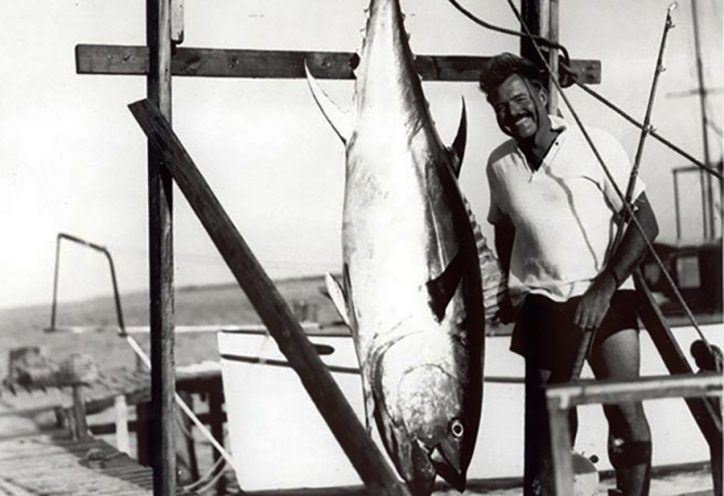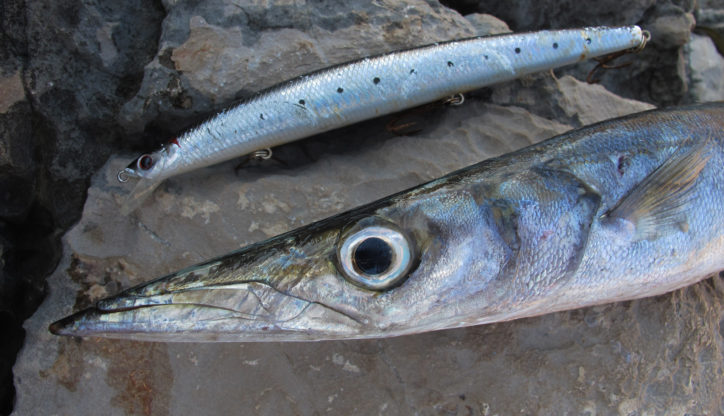Some people like beach holidays, others try to combine sunbathing with broadening of outlook, relying on tour guides or brief trips on leased cars from the beach, where the family decided to have a vacation. Some people hide from the sun in the room and slowly but surely taste drinks from the mini-bar. Others enjoy the southern sun.
What shall we do when we want to get around to fishing on vacation? Many questions arise even at home. What fish should be caught? What should be the jig? Where should we fish? Anyway, is it possible to fish on the sea abroad? On the one hand, there is a lot of information concerning this issue. On the other hand, it’s precious little.
It is scattered all over the Internet and print media. There is an amalgamation of tuna, goby, horse mackerel, venomous angelfish and shark in your head. You can even dream of a man holding a huge marlin that looks a little bit like Hemingway in photos posted on the Internet.

(Ernest Hemingway. Photo by © sportfishingmag.com)
Let’s try to bring matters under control a little.
This sketch is not supposed to be the ultimate truth. Besides, it doesn’t provide the answers to many questions. It’s all about a vacation and combining pleasant with useful, or useful with pleasant, if you say so: your family (girlfriend/children/wife/friends/you) enjoys sunbathing, and you find some time for your hobby, without wasting your time on ridiculous experiments.
So, you relax at the Adriatic seaside. However, most of the following material can be applied to the entire Mediterranean coast. In this case, species may vary, although more than 70% of fish found in the Mediterranean (the Adriatic Sea, like the Alboran, Balearic, Ionian, Cyprian, Cretan, Levantine, Libyan, Ligurian, Tyrrhenian and Aegean Seas, is a part of the Mediterranean Sea, just saying), inhabit the Adriatic. There will be the following differences in the seasonality of some species of fish: the species that “hibernate” in winter in the relatively cool Adriatic are quite active in neighboring warm parts of the Mediterranean coast. But, that’s it, I guess.
First of all you should try to understand how much time you can actually devote to fishing (the number of fishing rods, jigs and other gears you take will be directly proportional to this time). No matter how trivial and naive it sounds, eventually, it really turns out to be important. You can save several kilograms of excess weight of useless luggage. And if we talk about baggage, and you get to the seaside by plane, you should look through the conditions of transportation of your gear of the airline thoroughly – every company has its own rules. Sometimes outsize loads are accepted without charging up to 200 cm+, some airline companies accept them up to 150 cm+, and others have other conditions. Study this issue beforehand, so that you wouldn’t get into trouble at the airport.
Read the rules of sportfishing in the country you are going to visit (adriaticnature will help you figure out all the details of this issue in different articles). At least, remember that beach casting in Albania, Italy, Slovenia is allowed to everyone. If you are in Bosnia and Herzegovina, Croatia and Montenegro, you’ll have to get permission.
More than 400 species of fish inhabit the Adriatic Sea. You can hardly catch all of them in the course of one vacation. It’s hardly possible to do it in the course of one life as well. Nevertheless, there are fairly permanent participants of fishing single fights.
The water temperature in the Adriatic varies in different seasons. And, obviously, a lot of fish species inhabiting the sea have their peaks of activity and, and vice versa. There is the time when they hardly eat. This should be considered when planning your vacation. Otherwise, you should adjust to the free days you happen to have.
Considering the most frequent representatives of sea waters, their brief descriptions, seasons when a particular fish species is active, we’ll try to figure out what you can do at the seaside.
European seabass (European bass, branzino) and gilthead seabream (gilt-head bream) are fishes, which are certainly on everyone’s lips. They are sold virtually in every big supermarket of any country. They are known not so much for being extremely tasty, but for easily adapting to captive breeding. This particular feature makes them popular in different parts of the world. They were bred at fish farms and brought to the shelves of stores. Such a fate is their common feature. Besides, both species – the European seabass and gilthead seabream – are the inhabitants of the eastern part of the Atlantic Ocean and, and the Mediterranean Sea, in particular. These are the only similarities they have.

(European seabass (European bass, branzino). Photo by © adriaticnature)
The European seabass is definitely a predator. It’s a rather cunning and cautious predator. So catching the seabass is considered to be top class among fishermen for a reason. It’s not easy to catch it offhandedly – it will take some time to figure out its habits and preferences. As for the nearshore fish, catching 5 kilograms is a rather common but not frequent phenomenon. One thing about it is clear – it doesn’t like very warm water and prefers fresh cool water. It enjoys illuminated areas in the dark. The branzino is always near beaches, rock crevices in the shallows, debouchments of rivers.
The European bass has very good eyesight, it sees the fisherman as well as the multifilament when you use it while lure fishing. That’s why, it should be caught as carefully as possible, and you should always use fluorocarbon shock leader as a trace at least a meter long (one and a half meter is better). You should use ordinary fishing line at least. This rule is applied to almost all other sea fishes, and it is important. The seawater is transparent, the eyesight of the fish is excellent. If you want to catch the seabass, you can try to find it, when it’s really hot outdoors. It will be not that big. It’s better to use small jigs. Rain and sea swells are the best conditions to catch the seabass. You shouldn’t catch the European bass in the second half of January and February. This is the period, when it tries to finish spawning near the shore. Rather big seabasses are ready to face you from the first autumn till the last spring rains.
Soft plastic lures, as well as surface lures (walkers, poppers) and plugs are your best weapon. In case of silicone lures, you shouldn’t stint the length. Shads at least 7-9 cm long will be perfect when the European seabass is active. In summer, and, sometimes, on “whimsical” days, you should try and catch it using soft plastic lures shorter than 5 cm; walkers – 5 to 15 cm. Poppers are a quite aggressive lures, the seabass eats them when it has the right mood. If you are on a short vacation – you can postpone them until the next essential seabass coming. But if you need to catch the European seabass using a popper, 7-9 cm will be enough. Minnow-shaped plugs are 90-200 mm long. The seabass attacks plastic lures shorter than 90 mm, especially in summer, but the fish is rather small so you’ll have to let it go, anyway. Every country has its minimum length of the European bass. If it’s longer, you can withdraw the fish from water. It stands to reason that the catch and release principle should be followed when the seabass is less than 35-40 centimeters long.

(Gilthead seabream (gilt-head bream). Photo by © lebaneseaquacultureconsultancy.blogspot.com)
The gilt-head bream, which is sold on the shelves of stores, isn’t a half kilogram cooled fish. It is a desperate fighter caught by fishermen in the Adriatic, weighing up to 5-6 kilograms. It is the demersal fish, feeding on marine worms, mussels and other slowly moving and usually hard on the outside inhabitants of the seabed. It is caught using lures – silicone lures ones are preferred – but, first of all, this is the most desired take, when you use a feeder or just a leger rig.
It feeds on mussels and worms, and, of course, the bait of marine worms or mussels will attract it. It will be interested in chicken meat, all kinds of cheese and other delicacies on the hook – the gilthead seabream is capricious and sometimes, when catching it, you should take into account the food it prefers at the moment, for example, squid. And sometimes it can bite the bait of bread or dough. Use big hooks – keep in mind that this fish cracks shells of mollusks and has extremely strong jaws and teeth.
And, unlike the seabass, it likes warm water. The seabass and gilthead seabream are polar opposites in this matter. The more active the gilt-head bream is, the less active the European seabass is. And vice versa. So if you enjoy “quiet fishing”, the dorado is a desired trophy, especially for those anglers who are on summer vacation on the Adriatic coast. You can find it on beaches, shallows, depths, among bathers and in the wild. But, nevertheless, first of all, you’ll find it at the bottom, where there is enough food for gilt-head bream, whether it’s a beach, or a rocky shore with depths.

(Yellowmouth barracuda. Photo by © adriaticnature)
Now, we’re talking about the gilthead seabream that likes warm water and brings joy to the fans of fishing using live baits. But what should a fisherman, who likes to catch artificial lures, do in the hottest months? The easiest and most delicious trophy is the barracuda. In the cold months, catching it in the Adriatic Sea is a difficult task, but from April-May, and better from June – this is the real sea take of the spinner. The barracuda is a much less capricious predator than the seabass. It likes large baits. Its favorite ones are the oblong “minnow” plugs 150-200 mm long. It will take the silicone baits and topwater lures with pleasure as well. Most importantly, the latter one shouldn’t be the smallest. The only whim of barracuda is that it doesn’t like to hunt in the daytime. This twilight predator, which is most active at dusks and dawns, almost refuses to eat in the afternoon. You simply shouldn’t be lazy, and come to the seaside an hour prior to the dawn or an hour before the sunset, and your chances of catching fish will be very high. The boundaries of beaches and rocky coasts, rocky areas of the seabed with depths and coastal drops of depths – there are enough barracudas in the Adriatic Sea, the competition among them is huge, there is always a place with small fish, which the “sea pike” hunts for. Like many predators, the barracuda often visits small illuminated marinas for yachts and boats. Here it can be found in cooler seasons, but not only in cool seasons. The average weight of the barracuda in the Adriatic is about two kilograms, but the fish up to 5-6 kilograms are rather common as well.